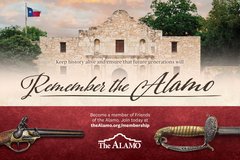During the week of February 10, 2020, there was no archaeological monitoring associated with the installation of the safety bollards. Work is focused on setting the bollards and pouring concrete. It is likely that the University of Texas at San Antonio’s Center for Archaeological Research (UTSA-CAR) archaeologists will return the week of February 24 to conduct additional monitoring.
Archaeology Update — Parallel Foundation From Early 1700s Discovered
Raba Kistner archaeologists continued with excavations associated with the Church and Long Barrack preservation. On the south side of the Church, two units were excavated to determine the depth of the foundation. Currently, the two units are at 51 and 55 inches below datum, with the base of the foundation not yet encountered. The archaeologists have encountered soils that contain few artifacts in both the south units. In both of the southern units, the archaeologists have created a smaller unit in the bigger one. In Excavation Unit 1, this is necessary as there is a parallel running alignment of stone that decreased the space in the overall unit.
The archaeologists have not been able to determine what this parallel alignment represents and are trying to gather more information. At this time, it is difficult to determine if the alignment is one continuous piece of stone or is made of smaller stones.
In Excavation Unit 1, this is necessary as there is a parallel running foundation that has decreased the amount of the unit that could be accessed. The parallel foundation appears to have been constructed before the currently standing Church foundation, and may have originated in the early 1700s. The archaeologists have exposed the profile of the older foundation as they are working to uncover the base of the current foundation.


On the north side of the Church, two units have been excavated to reveal the base of the north wall foundation. On the interior of the Church, Excavation Unit 7 has revealed the base of the foundation sitting on top of bedrock. On the exterior of the Church, Excavation Unit 8 is still revealing perpendicular stone foundations, as well as a compacted caliche floor. This week, the archaeologists have worked on documenting and removing the floor.
When comparing the elevations between Units 7 and 8, it appears that Unit 8 should be nearing the base of the foundation. The archaeologists are expecting to encounter the base in the next couple levels.



On the south side of the Long Barrack, Unit 9B is continuing to expose the foundation as well as uncovering some other architectural features. Last week, evidence of a wall foundation running north/south was uncovered in the western portion of the unit. The presence of the PVC storm drainpipe has created some issues for excavation. As the pipe cannot be removed, the archaeologists have reduced the size of the unit to allow them to continue exposing the foundation. A post-hole was observed in the southern portion of the unit.
Two other post-holes were observed during the excavation of the level. All three were in alignment, with one observed adjacent to the south wall of Long Barrack, another in the central portion of the unit, and the third (visible in Figure 5) located in the south wall of the excavation unit.
It appears that the archaeology associated with the preservation work will wind down in the next couple weeks. The goal was to locate the base of the foundation of the historic structures. With the units nearing the base of the foundation, the archaeologists will shift to documentation and then allow for the historic architects to complete their studies before backfilling. It is likely that excavations will be wrapped up by early March.


